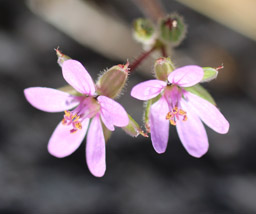 |
 |
Food:
"Costanoan Unspecified Raw stems used for food. --- Diegueno Vegtable Leaves picked early in the spring before the flowers appeared and cooked as greens. --- Hopi Candy Roots chewed by children, sometimes as gum. --- Isleta Forage High moisture content of leaves and stems made it good grazing plant for livestock. ---Kawaiisu Forage Plant eaten by horses, cows and rabbits. --- Navajo, Ramah Fodder Used for sheep feed. ---" (Moerman 225)
Medicine:
"Costanoan Misc. Disease Remedy Infusion of leaves used for typhoid fever. ---- Jemez Gynecological Aid Plant and roots eaten by women to produce more milk for the nursing children. --- Navajo, Kayenta Dermatological Plant used for wildcat, bobcat, or mountain lion bites. Disinfectant Plant used for infections. ---Zuni Dermatological Aid Poultice of chewed root applied to sores and rashes. Gastrointestinal Aid Infusion of root taken for stomachache. ---" (Moerman 225)
"When a diuretic is required, a handful of alfilerillo is boiled in a pint of water, strained, and the tea is drnnk while tepid. A bath is made for rheumatism and othere maladies by boiling larger quantities.
A remedy for gonorrhea (purgacion), is concocted similarly with a hand full of filaree, and equal quantity of yerba del burro (Distichlis spicata Greene), with a small piece of piloncillo (Mexican brown sugar) and one or two of the dry leaves that come from Mexico around the cone of piloncillo. A glassful, lukewarm, is drunk morning and night until the cure is effected. (Moore 14)
Other Uses:
"Jemez Protection Dried plant powder mixed with watermelon seeds during storage and planting stops watermelon disease. --- Navajo, Kayenta Ceremonial Items Used on proayer sticks. ---" (Moerman 225)